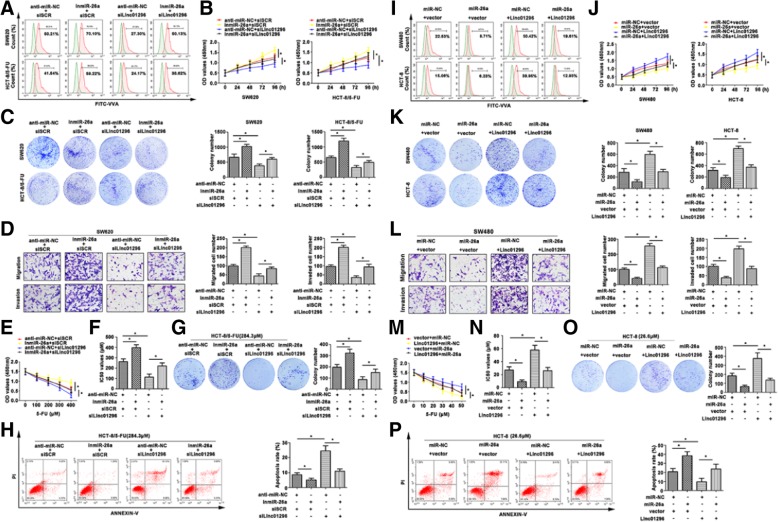Correction to: J Exp Clin Cancer Res (2018) 37:316
https://doi.org/10.1186/s13046-018-0994-x
In the publication of this article [1], there is an error in Fig. 5G (panel 2, group of InmiR-26a + siSCR in HCT-8/5-FU, treated with 284.3 μM). The revised Fig. 5 which includes 5G has now been included in this correction.
Fig. 5.
The effect of co-expression linc01296 and miR-26a on CRC progression. a Flow cytometry showed O-linked glycosylation level detected by fluorescein isothiocyanate (FITC)-conjugated VVA on the cell surface of transfected CRC cells. b CCK8 assay showed variant growth rate of transfected CRC cells. c Colony formation assay detected proliferative formation with different treated CRC cells. d Aggressiveness changed was determined by transwell assay, the migratory and invasive cells were counted. e CRC cells were treated with 5-FU, and the cell viability was detected by CCK8 assay. f IC50 values of treated CRC cells were calculated. g The effect of 5-FU on CRC cell proliferation was determined by colony formation assay. h Flow cytometry showed the apoptosis rate of transfected CRC cells in response to 5-FU. i FITC-VVA on transfected CRC cells surface was detected by flow cytometry. j The growth curves of transfected CRC cells were pictured after conducting CCK8 assay. k Proliferation of treated CRC cells was examined by colony formation assay. l Migration and invasion were observed in transfected SW620 cells. m With 5-FU treatment, the cell viability was determined by CCK8 assay. n The IC50 values were subsequently calculated. o 5-FU resistant CRC cells were transfected with linc01296 or miR-26a mimic, and the colony formation was counted in response to 5-FU. p The apoptosis rate of transfected CRC cells was detected after 5-FU treatment by flow cytometry. The data were means ± SD of three independent assays (*P < 0.05)
The correct Fig. 5 is given hereafter:
This error does not affect discussions and conclusions drawn in the article.
Reference
- 1.Liu B, Pan S, Xiao Y, et al. LINC01296/miR-26a/GALNT3 axis contributes to colorectal cancer progression by regulating O-glycosylated MUC1 via PI3K/AKT pathway. J Exp Clin Cancer Res. 2018;37:316. doi: 10.1186/s13046-018-0994-x. [DOI] [PMC free article] [PubMed] [Google Scholar]



